- E-mail:BD@ebraincase.com
- Tel:+8618971215294
The key components of the tetracycline (Dox)-induced gene expression system are tetracycline response element (TRE) and tetracycline repressor protein (TetR). After years of development, this system has also been optimized many times. The commonly used TRE is composed of 7 tetracycline resistance operons (TetO) with a length of 19 amino acids. TRE and the downstream CMV promoter together form a tetracycline-dependent Promoter (Ptet). The transformation of TetR has led to the gradual development of a variety of Tet regulatory systems. The most widely used are the inhibitory system Tet-off and the activation system Tet-on.
The tTA is a protein fused from TetR and the viral transcriptional activation domain VP16. Under physiological conditions, tTA actively binds to TRE to initiate gene expression; if Dox is administered, the combination of Dox and tTA dissociates from TRE, thereby inhibiting gene expression.
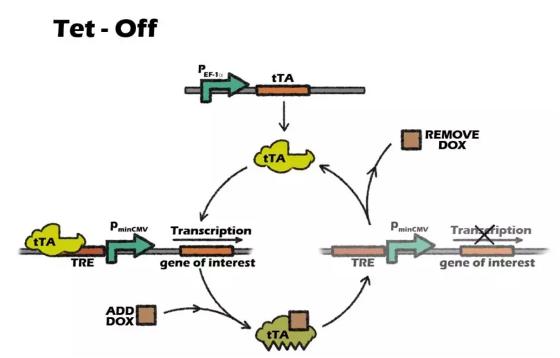
rtTA is a protein fused from rTetR and VP16, and its phenotype is opposite to that of tTA. Under physiological conditions, rtTA does not bind to TRE, and since PminCMV lacks an enhancer, the target gene is not expressed; after administration of Dox, the combination of Dox and rtTA binds to TRE, thereby initiating gene expression.
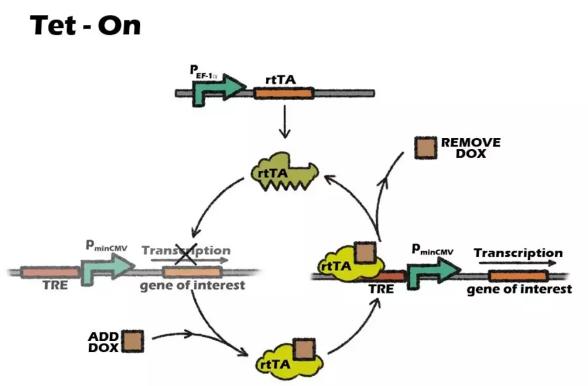
The tetracycline (Dox)-induced gene expression system is usually used for in vitro gene function, in vitro gene therapy, protein function, and mRNA function research, and is also used for in vivo experimental research [1]. In developmental and pathological studies, Veron et al. established "Tet-on"-induced glomerular podocyte vascular endothelial growth factor 164 (Podocyte VEGF164) overexpression transgenic mice and used them to study the relationship between Podocyte VEGF164 and Podocyte VEGF164 at various stages of development. relationship with kidney disease; in basic research on the nervous system, Blesch et al. used the "Tet-off" system to control the expression of nerve growth factor (NGF) in rat Alzheimer's disease model animals, achieving the goal of controlling the expression of nerve growth factor (NGF) in brain disease models. Regulating the expression of neurotrophic factors; in the study of nervous system functions and mechanisms, researchers such as Susumu Tonegawa [2-3] used "Tet-off" and "Tet-on" systems to combine optogenetics, chemical genetics, calcium imaging, etc. The technology has revealed the memory protection mechanism in the mammalian brain at the molecular mechanism level, providing a way to treat brain diseases such as Alzheimer's disease with memory loss and post-traumatic stress syndrome (PTSD) with intractable traumatic memories. A new idea for drug development; Wu Guangyan et al. studied at the brain level and revealed that PrL neurons in the prefrontal cortex are involved in regulating itching behavior by controlling attention shifts.
Researchers from Susumu Tonegawa's team[2] used the "Tet-off" system combined with light-sensitive proteins to label the memory trace cells related to fear memory in the mouse brain; when these labeled memory trace cells were activated by light, normal cells The rat then recalled the memory encoded by this group of cells. The AAV9-TRE-ChR2-EYFP virus was injected into the DG brain area of c-fos-tTA transgenic mice, and optical fibers were implanted at the same time. The presence of Dox inhibited the binding of tTA driven by the c-fos promoter to its target response element TRE site. , thereby preventing ChR2-EYFP expression. The mice enter the new environment A for training, inducing the expression of c-fos in relevant neurons. In the absence of drugs, the tTA-TRE system can work (with the addition of drugs, the system cannot work), so that it can Inducing the expression of ChR2-EYFP protein, ChR2 is inserted into the cell membrane, so that in this case, the cells involved in the learning and memory process are marked by the ChR2-EYFP protein. Studies have shown that optogenetic stimulation of hippocampal engram cells can activate fear memory recall in mice.
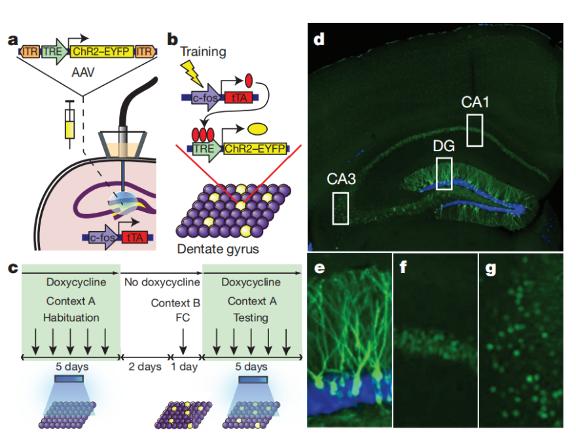
Susumu Tonegawa said that in the early stages of Alzheimer's disease (AD), patients usually do not remember what they have experienced recently. These memories are still stored in the brain, but the patients have no way to access them [3]. They then applied this engram cell identification and optogenetic manipulation technology to 7-month-old AD mice to determine whether memory could be restored in the early stages of the disease. Using a dual adeno-associated virus system, AAV9-c-Fos-tTA and AAV9-TRE-ChR2-eYFP were injected into the DG brain area of 7-month-old AD mice to label contextual conditioned fear memory-related imprinting cells. Although DG neurons completely lacked ChR2-eYFP labeling on the DOX diet, 1 day of Dox withdrawal was sufficient to stably express ChR2-eYFP in the brains of 7-month-old AD mice and control mice, showing that in early Alzheimer's disease In a transgenic mouse model of Alzheimer's disease, optogenetic activation of mouse hippocampal memory engram cells resulted in memory retrieval.
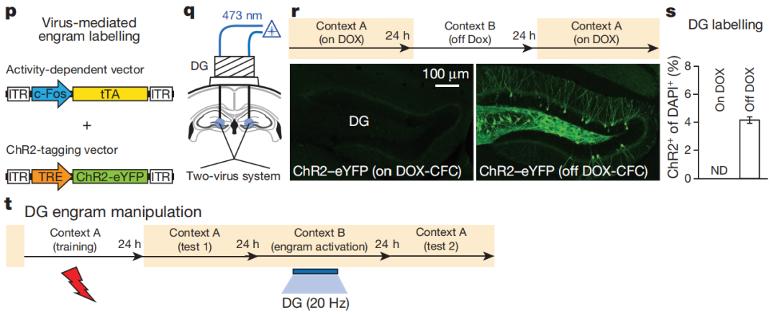
Researchers such as Guan Jisong from the School of Life Sciences of Tsinghua University published an article titled "Activity-induced histone modifications govern Neurexin-1 splicing and memory preservation" in the journal Nature Neuroscience on March 27 [4], discovering the discovery of post-learning memory The activity of engram-related neurons can cause epigenetic modifications, leaving long-term imprints in memory-related neurons. To investigate whether the histone methyltransferase Suv39h1 in the hippocampus is critical for memory preservation but not for memory encoding or recall, the researchers selectively knocked out Suv39h1 in the hippocampus through the "Tet-on" system. , using lentivirus-mediated Dox-induced micro-RNA expression system. Dox induction significantly reduced the expression of Suv39h1 in the DG. The results showed that down-regulation of Suv39h1 (Suv39h1KD) did not affect the retrieval of recent memory in mice 1 hour after training, suggesting that Suv39h1 deletion may not affect memory encoding.
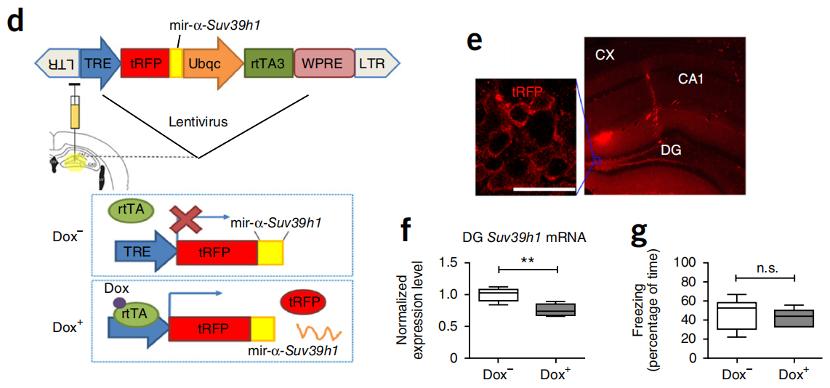
Wu Guangyan and other teams from the School of Basic Medicine of Army Medical University published a research paper titled "The prelimbic cortex regulates itch processing by controlling attentional bias" in the international academic journal iScience on December 29, 2022 [5]. The researchers introduced c -Fos labeling system and "Tet-off" system, label itch-specific neurons and attention-related neurons, combine with calcium imaging to record the activity of labeled neurons, and regulate neuronal activity through optogenetics and chemical genetics to explore Whether there are neurons specifically involved in regulating itch in the prelimbic cortex (PrL) of the brain. AAV9-c-Fos-tTA and AAV9-TRE-tight-jGCaMP7s were mixed and injected into the PrL area of rats. After virus injection, the rats were fed a Dox diet to prevent the expression of jGCaMP7s or EGFP. Four weeks after virus injection, Dox feeding was suspended for 3 days, 5-HT was injected to induce itch source, and itch-specific neurons were labeled by jGCaMP7s or EGFP. Resume Dox diet feeding immediately after marking to ensure there are no other factors interfering. On the basis of labeling itch-specific neurons, calcium imaging recordings revealed that the activity of PrL itch-specific neurons was significantly elevated during itch. In addition, the Tet-Off system was combined with chemical genetic specific labeling and inhibition of PrL itch-specific neurons to further manipulate the itch-responsive neurons in PrL. The animals' itch-scratch behavior was significantly inhibited, confirming the PrL itch-specificity. Neurons are indeed involved in regulating itch.
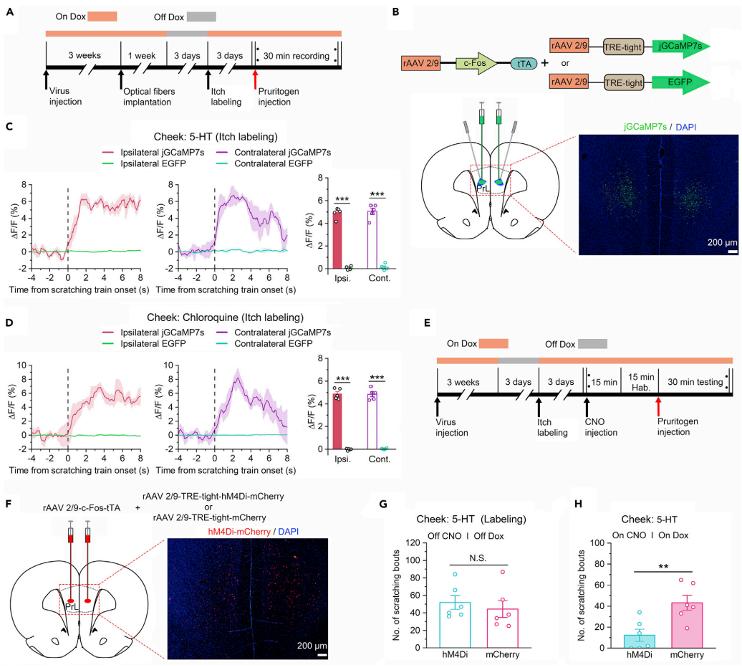
The study found that Lena et al. [6] used a high-capacity adenovirus vector to load the Tet-on system composed of rtTA and tTS to express erythropoietin (EPO), and used mouse tissue-specific promoters to avoid immune responses, ultimately making The target gene can be expressed in animals for 30 weeks, which provides ideas for long-term in vivo gene therapy. The tetracycline (Dox)-induced gene expression system has a very broad application space in gene therapy and research because of its high efficiency, safety, rigor, and clear mechanism.
[1] Chen Hao, Xia Haibin. Research and application of tetracycline-induced regulated expression system [J]. Chemistry of Life, 2011, 31(02): 285-291.
[2] Liu X, Ramirez S, Pang PT, et al. Optogenetic stimulation of a hippocampal engram activates fear memory recall. Nature. 2012;484(7394):381-385.
[3] Roy DS, Arons A, Mitchell TI, Pignatelli M, Ryan TJ, Tonegawa S. Memory retrieval by activating engram cells in mouse models of early Alzheimer's disease. Nature. 2016;531(7595):508-512.
[4] Ding X, Liu S, Tian M, et al. Activity-induced histone modifications govern Neurexin-1 mRNA splicing and memory preservation. Nat Neurosci. 2017;20(5):690-699.
[5] Wu GY, Zheng XX, Zhao SL, et al. The prelimbic cortex regulates itch processing by controlling attentional bias. iScience. 2022;26(1):105829.
[6] Lena AM, Giannetti P, Sporeno E, Ciliberto G, Savino R. Immune responses against tetracycline-dependent transactivators affect long-term expression of mouse erythropoietin delivered by a helper-dependent adenoviral vector. J Gene Med. 2005;7(8):1086-1096.
The following interpretation only represents Xiaobu's personal understanding and opinion of the article. All the pictures used in this interpretation are from the original text. If you need more information, please refer to the original literature